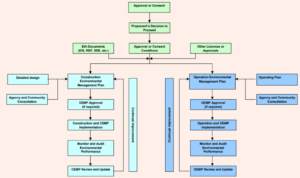Back to: Environmental Biology 400 Level
Welcome to class!
Have you ever watched a big construction project and wondered, “How will they make sure this doesn’t damage the environment?” The answer lies in a well-prepared Environmental Management Plan, or EMP. An EMP is like a roadmap that outlines exactly how a project will avoid, reduce, or fix environmental problems during and after its execution.
Environmental Management Plan (EMP)
What is an Environmental Management Plan (EMP)?
An Environmental Management Plan is a detailed action plan developed after an Environmental Impact Assessment (EIA) has identified potential environmental risks. It explains what will be done, who will do it, when it will be done, and how success will be measured. Think of it as the implementation tool that ensures environmental promises made during the EIA process are actually carried out.

Purpose of the EMP
To manage and monitor the environmental impacts of a project
To outline specific actions to avoid, reduce, or correct negative impacts
To assign responsibilities and ensure accountability
To satisfy regulatory and legal requirements
To protect nearby communities and ecosystems
Key Components of an EMP
Mitigation Measures
These are actions to reduce or prevent the environmental damage identified in the EIA. For example, if a mining project is likely to cause erosion, mitigation could include planting grasses and building terraces to stabilise the soil.
Monitoring Programme
Monitoring involves regular checks to ensure that environmental standards are being maintained. For example, a project near the River Niger may involve frequent water sampling to monitor pollution levels.

Institutional Arrangements
The EMP identifies who is responsible for what. This includes environmental officers, project contractors, regulators, and sometimes the local community.
Emergency Response Plans
These plans prepare the project team to respond quickly and effectively if things go wrong. For instance, an oil company should have a clear action plan for dealing with a spill—who to call, what tools to use, and how to prevent the spread.
Training and Capacity Building
An EMP should include education and training for workers and stakeholders. This ensures everyone understands their role in protecting the environment, from equipment operators to security staff.
Cost Estimates and Budgeting
The EMP must clearly show how much each environmental action will cost and where the funds will come from. This prevents the environment from being ignored due to lack of funding.
Nigerian Example: Lekki Deep Sea Port EMP

During the planning of the Lekki Deep Sea Port, the EMP addressed key issues like mangrove protection, fish migration, and waste management. With proper implementation, the port is now one of Nigeria’s best examples of balancing development and environmental responsibility.
Summary
- An Environmental Management Plan (EMP) is a tool for ensuring that environmental safeguards identified in the EIA are implemented.
- The purpose of the EMP is to reduce impacts, assign responsibilities, and ensure compliance with environmental regulations.
- Components include mitigation measures, monitoring, roles, emergency plans, training, and budgeting.
- An EMP helps ensure that development projects are environmentally sustainable.
- Projects like the Lekki Port show how a good EMP can support both growth and environmental protection.
Evaluation
- What is the purpose of an Environmental Management Plan?
- List and briefly explain three key components of an EMP.
- Why is monitoring important in an EMP?
- Who are the stakeholders involved in EMP implementation?
- Give an example of a Nigerian project that required an EMP and explain why.
Well done on taking your learning seriously. Every time you study environmental management, you prepare yourself to lead Nigeria toward a greener, safer future. Keep it up—you’re doing brilliantly, and Afrilearn is proud to support your journey!
